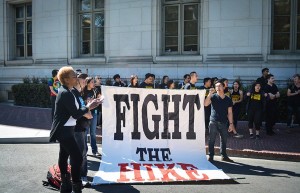
UC Berkeley is Running out of Money. Here is What They Plan to Do
Despite having a huge technology boom in their backyard, the finances of UC Berkeley are diving into deep red.
The Chronicle of Higher Education reports in “Acknowledging New Normal, Berkeley Announces Broad Plan to Shore Up Finances” -
Citing a new normal of diminished state funding, the University of California at Berkeley is launching a strategic-planning process aimed at shoring up its finances. In a message to the campus on Wednesday morning, the universitys chancellor, Nicholas B. Dirks, laid out several broad areas for change the university will consider.
Specifics about the strategic-planning process are scarce. What is clear, however, is the universitys harsh financial outlook. According to a financial summary provided by a university spokesman, Berkeley faces a $150-million deficit for the current fiscal year, representing 6 percent of its operating budget.
Here are the expected plans from the above article. We also provide plain- English interpretation of MBA-speak -
Proposal 1. Raising revenue through the use of the universitys brand, land, and other assets.
In plain English, (i) raise tuition on suckers, (ii) take loans on the buildings, (iii) lease some of the UC land to private companies. Among those, the first option is possibly out, given that-
UC Berkeley and Oakland high school students protest tuition hikes, other higher education issues

Students from both UC Berkeley and Oakland Technical High School organized two demonstrations on campus Wednesday one to protest proposed tuition hikes and the other to advocate admitting more Oakland public school students to UC Berkeley.
The UC Berkeley students demonstration called a funeral for public education was a part of the 96 Hours of Action, a series of protests throughout UC campuses against a tuition hike policy passed in November. The protesters carried a cardboard coffin representing the death of Californias public education system. They began on Sproul Plaza, walked to California Hall and then marched back to Telegraph Avenue and Bancroft Way, blocking traffic for a short period of time.
-——————————–
Proposal 2. The realignment of some of the universitys academic parts by bolstering some units and combining others to capture intellectual synergies.
“Realignment” is code-word for “downsizing”, which itself is a code-word for getting rid of employees. Given that UCs cannot fire tenured professors yet, this step will lead to combining departments and cutting on everything else. This is gonna be fun.
-——————————–
Proposal 3. Better supporting teaching and research while also redesigning many of our work processes in order to achieve greater efficiency.
This is MBA speak with no additional action beyond proposal 2. Maybe they will replace classroom lectures with videos from Coursera and TAs with robots from Google :). “Efficiency” always means replacing humans with “smart” machines.
-————————————————————————
We should point out that none of those are going to work. What is UC Berkeley’s real problem? It is the Federal Reserves cutting interest rate to 0%, and bleeding all kinds of savings funds. Let me explain.
Suppose an organization needs to hire a tenured professor. That means the organization needs to make sure it can provide steady salary for the person for many years.
Think about it this way. Suppose you run a company, and want to hire an employee with a six-month contract of $10,000/month. That means your company needs to secure $60K of cash flow to make sure the employee contract is not violated. Historically, that cash flow came either from continuing business or interests on savings made by the business. For charitable institutions, the second option historically played big role.
For example, if the company had $1M in bank earning 6%, it could use the earned interest to pay the employee’s salary without worrying about business prospects. Many organizations like universities and charitable non-profits had substantial savings, and they used the interest to pay for employees in perpetuity. Even the Nobel Foundation uses the same model for paying the prize in perpetuity. This kind of ‘paying perpetually from interest’ calculations were routine everywhere. For example, I remember, when our family made a small donation for a college award several years back, the head of the college did the same interest rate calculation to explain how much the donation needed to be for the award amount.
Zero percent interest rate throws a monkey wrench into the entire model and especially damages long-term hiring. US treasury 10 year bond produces 1.7% interest at present. Therefore, to permanently hire someone with the salary of $200K/year from the interest, an organization needs to keep $6M in 10 year treasury bonds, whereas the requirement was only one third of that a few years back. So, UC Berkeley has to either dramatically increase its savings fund with each drop in interest rate, or cut down on ambitions of hiring tenured professors. Most universities are going for the second option.
Are we glad that these universities are suffering? Absolutely, given that this dumb economic model of lowering interest rate to support banks came from none other than the academics from various top US universities.

Finally, if you think 0% interest rate is the end of this nonsense, you may be glad to know that the academics are talking about deep negative interest rates (check - JPM’s Striking Forecast: ECB Could Cut Rates To -4.5%; BOJ To -3.45%; Fed To -1.3%). God bless UC Berkeley, when that happens.
The above money problems are another reason UC Berkeley is going for all-or- nothing CRISPR-cas9 court battle with Harvard/MIT/Broad. Readers may check “CRISPR Fight and the Corrosive Role of Bayh-Dole Act in Damaging Basic Science”.